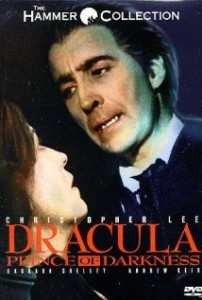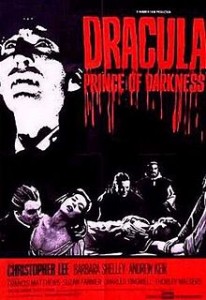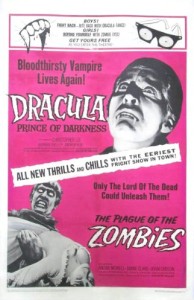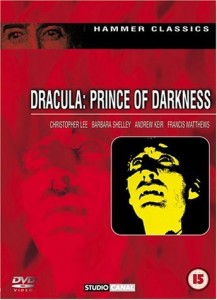Dracula: Prince of Darkness **** (1966, Christopher Lee, Barbara Shelley, Francis Matthews, Andrew Keir) – Classic Movie Review 1734
After a long gap, Hammer Films’ 1966 sequel to its finest achievement – the 1958 Dracula – resurrects the Count with the inestimable help of ultra-smooth Christopher Lee back in his most famous role as Dracula again. And the script resurrects the Count with the blood of an unwary overnight visitor to Castle Dracula in 19th-century Carpathia. And, yes, the butler did it!
Director Terence Fisher’s Dracula: Prince of Darkness follows the Lee-free Brides of Dracula and just forgets about it. Dracula: Prince of Darkness is just a single notch down from Fisher’s original though the lack of Peter Cushing’s authoritative star presence is felt. But Jimmy Sangster’s ingenious screenplay (credited as by John Sansom) and Fisher’s commanding direction produce another entertaining horror movie that was again a big hit and still commands respect and affection.
In the story, two married couples (Francis Matthews as Charles and Suzan Farmer as Diana; Charles ‘Bud’ Tingwell as Alan and Barbara Shelley as Helen) travelling in Eastern Europe ignore warnings to visit Karlsbad. As night falls, their coachman abandons them, but they enter a castle where they are greeted by the sinister butler Klove (Philip Latham). The castle owner is a certain Count Dracula, who has been dead and loving it for ten years, but this visit is going to revive him quite nicely.
Between them, Francis Matthews and Andrew Keir take on the Peter Cushing-style role of Dracula’s adversaries and vampire slayers, and both of them are good, particularly the authoritative Keir as the grimly determined priest Father Sandor. Barbara Shelley screams and goes crazy most impressively, Latham is a chilling, looming, lugubrious presence, and Thorley Walters is enjoyable as a crazy Renfield-style character called Ludwig.
Though top-billed Christopher Lee has fairly limited screen time, arriving late on in the movie, and does not speak in the film, apart from a few hisses, he still menaces and bites necks satisfyingly. Christopher Lee said: ‘I didn’t speak in that picture. The reason was very simple. I read the script and saw the dialogue! I said to Hammer, if you think I’m going to say any of these lines, you’re very much mistaken.’ Sangster denies this, saying: ‘Vampires don’t chat. So I didn’t write him any dialogue.’
Christopher Lee’s top billing in a role with no dialogue and tiny screen time must be a record in the movies.
Barbara Shelley, Thorley Walters, Andrew Keir as the priest Father Sandor, Francis Matthews, Suzan Farmer and Charles Tingwell also star. Philip Latham, Walter Brown, George Woodbridge, Jack Lambert, Philip Ray, Joyce Henson and John Maxim are also in the cast.
To help things get going again, the movie starts with a clip from the final scenes of the 1958 Dracula, showing Dracula’s death at the hands of Dr Van Helsing (Peter Cushing) accompanied by narration. The script’s story idea is by Anthony Hinds (credited to John Elder), inspired by the classic novel by Bram Stoker, though it bears little or no resemblance to it. The film is photographed in Techniscope by Michael Reed, designed by Bernard Robinson and scored by James Bernard. Once again from Terence Fisher, it is a good looking film, confidently and strikingly made.
Made back to back at Bray Studios, Berkshire, with Rasputin, the Mad Monk, using many of the same sets and cast, the film opened in London on 9 January 1966 and was also released in a double bill with The Plague of the Zombies.
Plastic vampire fangs and cardboard zombie eyes glasses were distributed to audiences as a gimmick. It was restored in 2K and re-screened in cinemas before being released on Blu-ray in 2012.
Next up: Dracula Has Risen from the Grave (1968).
© Derek Winnert 2014 Classic Movie Review 1734
Check out more reviews on http://derekwinnert.com/









